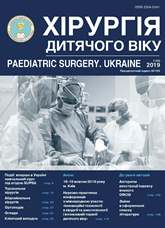Analysis of the results of using the pediatric appendicitis score in the differential diagnosis of abdominal pain in children aged 5–17 years
DOI:
https://doi.org/10.15574/PS.2019.63.23Keywords:
acute appendicitis, children, diagnostics, PASAbstract
Accurate and timely diagnostics of the acute appendicitis (AA) in children remains an actual question. One of the directions is the development of standard diagnostic scales, including clinical symptoms and laboratory data.
Aim. Analysis of the results of using the Pediatric Appendicitis Score (PAS) in the differential diagnostics of abdominal pain in children aged 5–17 years.
Materials and methods. The prospective randomized blind clinical trial. 326 children were examined with abdominal pain at the age of 5–17 years.
Results. The Pediatric Appendicitis Score has a different diagnostic significance in the recommended ranges of values. The level of errors of the first kind contains 6% (DI 0.0–12.6) in the conclusion «low risk of AA». The errors of the second kind (negative appendectomy) is 20% (DI 7.6–32.4) with values of the PAS more than 7 points.
Conclusions. It is advisable to study further the diagnostic ability of the Pediatric Appendicitis Score. The obtained data requires the study the Pediatric Appendicitis Score in different age groups in order to reduce the number of uncertain conclusions, to improve the accuracy of diagnostics of the destructive appendicitis.
References
Kaminski MN. (2017). Comparative assessment and optimization of clinical and sonoscopic scales of acute appendicitis. Khabarovsk: 24. http://www.fesmu.ru/SITE/files/editor/file/nauka/avtoref/avtoref_kam.pdf
Kasimov RR, Muchin AS, Elfimov DA. (2014). Medic and diagnostic algorithm in military personnel with acute appendicitis. Novosti Khirurgii. 22(1): 89–95. https://doi.org/10.18484/2305-0047.2014.1.89
Kushnir AV, Zuev VV. (2015). Ultrasound diagnostics and computed tomography in the diagnostics of acute appendicitis. Bulletin of Medical Internet conferences. 5(5): 627.
Magomedova S. (2016). The frequency of detection of acute appendicitis with atypical location of the appendix. Bulletin of Scientific Conferences. 9 (4): 67–68.
Alhamdani YF. (2018). Negative Appendectomy Rate and Risk Factors That Influence Improper Diagnosis at King Abdulaziz University Hospital. Mater. Sociomed. 30(3): 215–220. https://doi.org/10.5455/msm.2018.30.215-220; PMid:30515062 PMCid:PMC6195398
Alvarado A. (1986) A practical score for the early diagnosis of acute appendicitis. Annals of emergency medicine. 15(5): 557–564. https://doi.org/10.1016/S0196-0644(86)80993-3
Andersson RE, Andersson M. (2008). The Appendicitis Inflammatory Response Score: A Tool for the Diagnosis of Acute Appendicitis that Outperforms the Alvarado Score. World Journal of Surgery. 32(8): 1843–1849. https://doi.org/10.1007/s00268-008-9649-y; PMid:18553045
Carroll PJ, Gibson D. (2013). Surgeon-performed ultrasound at the bedside for the detection of appendicitis and gallstones: systematic review and meta-analysis. American journal of surgery. 205(1): 102–108. https://doi.org/10.1016/j.amjsurg.2012.02.017; PMid:22748292
Chong CF. (2010). Development of the RIPASA score: a new appendicitis scoring system for the diagnosis of acute appendicitis. Singapore Med Journal 51(3): 220–225.
Hakkoymaz H, Nazik S, Seyithanoglu M. (2019). The value of ischemia-modified albumin and oxidative stress markers in the diagnosis of acute appendicitis in adults. The American journal of emergency medicine. https://www.ncbi.nlm.nih.gov/pubmed/30871739 ; https://doi.org/10.1016/j.ajem.2019.03.005; PMid:30871739
Kim JS. (2013). Acute Abdominal Pain in Children. Pediatr Gastroenterol Hepatol Nutr. 16 (4): 219–224. https://doi.org/10.5223/pghn.2013.16.4.219; PMid:24511517 PMCid:PMC3915729
Lintula H, Pesonen E, Kokki H. (2005). A diagnostic score for children with suspected appendicitis. Langenbeck’s archives of surgery. 390(2): 164–70. https://doi.org/10.1007/s00423-005-0545-8; PMid:15723233
Papes D, Srsen MS, Antabak A. (2015). What Is the Acceptable Rate of Negative Appendectomy? Comment on Prospective Evaluation of the Added Value of Imaging within the Dutch National Diagnostic Appendicitis Guideline – Do We Forget Our Clinical Eye? Digestive surgery. 32(3): 181–182. https://doi.org/10.1159/000380772; PMid:25833673
Reuben A. (2016). Examination of the abdomen. Clinical Liver Disease. 7(6): 143–150. https://doi.org/10.1002/cld.556; PMid:31041050 PMCid:PMC6490278
Salo M. (2014). Appendicitis in Children: Evaluation of the Pediatric Appendicitis Score in Younger and Older Children. Surgery research and practice. https://www.ncbi.nlm.nih.gov/pubmed/25574500 ; https://doi.org/10.1155/2014/438076; PMid:25574500 PMCid:PMC4276704
Sammalkorpi H. (2017). Diagnosis of acute appendicitis: diagnostic scoring and significance of preoperative delay (Doctoral dissertation). Retrieved from: https://helda.helsinki.fi/bitstream/handle/10138/179225/DIAGNOSI.pdf?sequence=1
Samuel M. (2001). Pediatric Appendicitis Score. Journal of Pediatric Surgery. https://www.mdcalc.com/pediatricappendicitis-score-pas.
Shommu NS, Jenne CN, Blackwood J. (2018). Metabolomic and inflammatory mediator based biomarker profiling as a potential novel method to aid pediatric appendicitis identification. PLOS ONE. 13(3): e0193563. https://doi.org/10.1371/journal.pone.0193563; PMid:29529041 PMCid:PMC5846776
Unal Y. (2018). A new and early marker in the diagnosis of acute complicated appendicitis: immature granulocytes. Turkish journal of trauma & emergency surgery. 24(5): 434–439. https://doi.org/10.5505/tjtes.2018.91661
Yap TL, Fan JD, Chen Y. (2019). A novel noninvasive appendicitis score with a urine biomarker. Journal of pediatric surgery. 54(1): 91–96. https://doi.org/10.1016/j.jpedsurg.2018.10.025; PMid:30391151
Downloads
Issue
Section
License
The policy of the Journal “PAEDIATRIC SURGERY. UKRAINE” is compatible with the vast majority of funders' of open access and self-archiving policies. The journal provides immediate open access route being convinced that everyone – not only scientists - can benefit from research results, and publishes articles exclusively under open access distribution, with a Creative Commons Attribution-Noncommercial 4.0 international license(СС BY-NC).
Authors transfer the copyright to the Journal “PAEDIATRIC SURGERY.UKRAINE” when the manuscript is accepted for publication. Authors declare that this manuscript has not been published nor is under simultaneous consideration for publication elsewhere. After publication, the articles become freely available on-line to the public.
Readers have the right to use, distribute, and reproduce articles in any medium, provided the articles and the journal are properly cited.
The use of published materials for commercial purposes is strongly prohibited.

